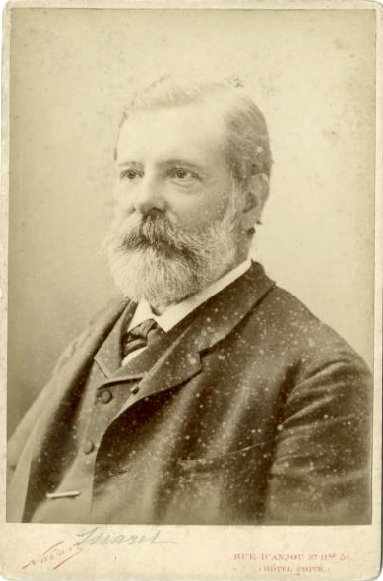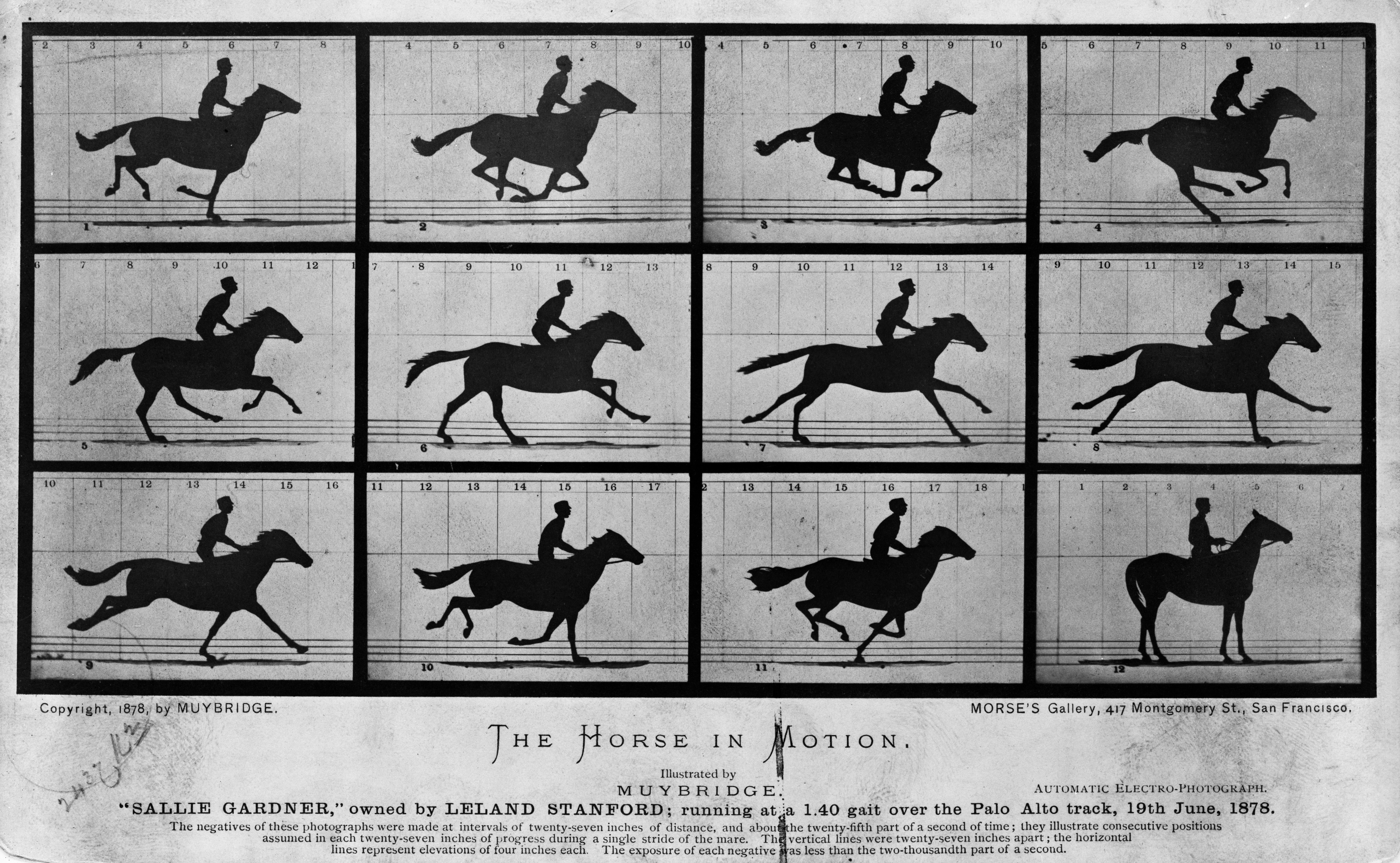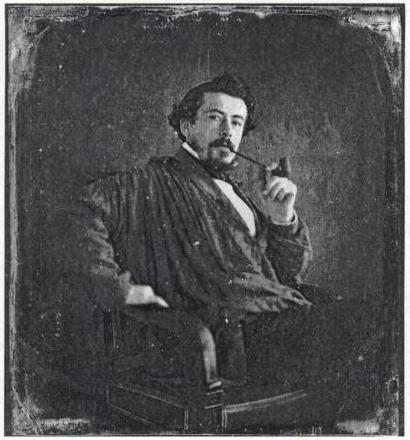|
Chronophotographer
Chronophotography is a photographic technique from the Victorian era which captures a number of phases of movements. The best known chronophotography works were mostly intended for the scientific study of locomotion, to discover practical information for animal handlers and/or as reference material for artists. Although many results were not intended to be exhibited as moving pictures, there is much overlap with the more or less simultaneous quest to register and exhibit photographic motion pictures. Definition Chronophotography is defined as "a set of photographs of a moving object, taken for the purpose of recording and exhibiting successive phases of motion". The term ''chronophotography'' was coined by French physiologist Étienne-Jules Marey to describe photographs of movement from which measurements could be taken and motion could be studied. It is derived from the Greek word χρόνος '' chrónos'' ("time") combined with ''photography''.The J. Paul Getty Museum (1990). ... [...More Info...] [...Related Items...] OR: [Wikipedia] [Google] [Baidu] |
Étienne-Jules Marey
Étienne-Jules Marey (; 5 March 1830, Beaune, Côte-d'Or – 15 May 1904, Paris) was a French scientist, physiologist and chronophotographer. His work was significant in the development of cardiology, physical instrumentation, aviation, cinematography and the science of laboratory photography. He is widely considered to be a pioneer of photography and an influential pioneer of the history of cinema. He was also a pioneer in establishing a variety of graphical techniques for the display and interpretation of quantitative data from physiological measurement. Biography Marey started by studying Circulatory system, blood circulation in the human body. Then he shifted to analyzing heart beats, respiration, muscles (myography), and movement of the body. To aid his studies he developed many instruments for precise measurements. For example, in 1859, in collaboration with the physiologist Auguste Chauveau and the watch manufacturer Breguet (brand), Breguet, he developed a wearable ' ... [...More Info...] [...Related Items...] OR: [Wikipedia] [Google] [Baidu] |
Albert Londe
Albert Londe (26 November 1858 – 11 September 1917) was an influential French photographer, medical researcher and chronophotographer. He is remembered for his work as a medical photographer at the Salpêtrière Hospital in Paris, funded by the Parisian authorities, as well as being a pioneer in X-ray photography. During his two decades at the Salpêtrière, Albert Londe developed into arguably the most outstanding scientific photographer of his time. In 1878 neurologist Jean-Martin Charcot hired Londe as a medical photographer at the Salpêtrière. In 1882 Londe devised a system to photograph the physical and muscular movements of patients (including individuals experiencing epileptic seizures). This he accomplished by using a camera with nine lenses that were triggered by electromagnetic energy, and with the use of a metronome he was able to sequentially time the release of the shutters, therefore taking photos onto glass plates in quick succession. A few years later Lon ... [...More Info...] [...Related Items...] OR: [Wikipedia] [Google] [Baidu] |
Female Nude Motion Study By Eadweard Muybridge (2)
Female (symbol: ♀) is the sex of an organism that produces the large non-motile ova (egg cells), the type of gamete (sex cell) that fuses with the male gamete during sexual reproduction. A female has larger gametes than a male. Females and males are results of the anisogamous reproduction system, wherein gametes are of different sizes, unlike isogamy where they are the same size. The exact mechanism of female gamete evolution remains unknown. In species that have males and females, sex-determination may be based on either sex chromosomes, or environmental conditions. Most female mammals, including female humans, have two X chromosomes. Female characteristics vary between different species with some species having pronounced secondary female sex characteristics, such as the presence of pronounced mammary glands in mammals. In humans, the word ''female'' can also be used to refer to gender in the social sense of gender role or gender identity. Etymology and usage The ... [...More Info...] [...Related Items...] OR: [Wikipedia] [Google] [Baidu] |
Phenakistiscope
The phenakistiscope (also known by the spellings phénakisticope or phenakistoscope) was the first widespread animation device that created a fluent illusion of motion. Dubbed and ('stroboscopic discs') by its inventors, it has been known under many other names until the French product name became common (with alternative spellings). The phenakistiscope is regarded as one of the first forms of moving media entertainment that paved the way for the future motion picture and film industry. Like a GIF animation, it can only show a short continuous loop. Etymology and spelling When it was introduced in the French newspaper ''Le Figaro'' in June 1833, the term 'phénakisticope' was explained to be from the root Greek word ''phenakistikos'' (or rather from φενακίζειν ''phenakizein''), meaning "deceiving" or "cheating", and ὄψ ''óps'', meaning "eye" or "face", so it was probably intended loosely as 'optical deception' or 'optical illusion'. The term phénakisticop ... [...More Info...] [...Related Items...] OR: [Wikipedia] [Google] [Baidu] |
The Horse In Motion
''The Horse in Motion'' is a series of cabinet cards by Eadweard Muybridge, including six cards that each show a sequential series of six to twelve "automatic electro-photographs" depicting the movement of a horse. Muybridge shot the photographs in June 1878. An additional card reprinted the single image of the horse "Occident" trotting at high speed, which had previously been published by Muybridge in 1877. The series became the first example of chronophotography, an early method to photography, photographically record the passing of time, mainly used to document the different phases of locomotion for scientific study. It formed an important step in the development of Film, motion pictures for years to come. Muybridge's work was commissioned by Leland Stanford, the industrialist, former Governor of California, and horseman, who was interested in horse gait analysis. in 1882, Stanford had a book published about the project, also entitled ''The Horse in Motion'', with circa ... [...More Info...] [...Related Items...] OR: [Wikipedia] [Google] [Baidu] |
Eadweard Muybridge
Eadweard Muybridge (; 9 April 1830 – 8 May 1904, born Edward James Muggeridge) was an English photographer known for his pioneering work in photographic studies of motion, and early work in motion-picture projection. He adopted the first name "Eadweard" as the original Anglo-Saxon form of "Edward", and the surname "Muybridge", believing it to be similarly archaic. Born in Kingston upon Thames, England, at the age of 20 he emigrated to the United States as a bookseller, first to New York City, and eventually to San Francisco. In 1860, he planned a return trip to Europe, and suffered serious head injuries in a stagecoach crash in Texas en route. He spent the next few years recuperating in Kingston upon Thames, where he took up professional photography, learned the wet-plate collodion process, and secured at least two British patents for his inventions. He returned to San Francisco in 1867, a man with a markedly changed personality. In 1868, he exhibited large photographs o ... [...More Info...] [...Related Items...] OR: [Wikipedia] [Google] [Baidu] |
Leland Stanford
Amasa Leland Stanford (March 9, 1824June 21, 1893) was an American industrialist and politician. A member of the Republican Party, he served as the 8th governor of California from 1862 to 1863 and represented California in the United States Senate from 1885 until his death in 1893. He and his wife Jane were also the founders of Stanford University, which they named after their late son. Prior to his political career, Stanford was a successful merchant and wholesaler who built his business empire after migrating to California during the Gold Rush. As president of the Central Pacific Railroad and later the Southern Pacific from 1885 to 1890, he held tremendous power in the region and a lasting impact on California. Early life and career Leland Stanford was born in 1824 in what was then Watervliet, New York (now the Town of Colonie). He was one of eight children of Josiah and Elizabeth Phillips Stanford. Among his siblings were New York State Senator Charles Stanford (1819– ... [...More Info...] [...Related Items...] OR: [Wikipedia] [Google] [Baidu] |
Snapshot (photography)
A snapshot is a photograph that is "shot" spontaneously and quickly, most often without artistic or journalistic intent and usually made with a relatively cheap and compact camera. Common snapshot subjects include the events of everyday life, often portraying family members, friends, pets, children playing, birthday parties and other celebrations, sunsets, tourist attractions and the like. Snapshots can be technically "imperfect" or amateurish: poorly framed or composed, out of focus, and/or inappropriately lighted by flash. Automated settings in consumer cameras have helped to obtain a technologically balanced quality in snapshots. Use of such settings can reveal the lack of expert choices that would entail more control of the focus point and shallower depth of field to achieve more pleasing images by making the subject stand out against a blurred background. Snapshot photography can be considered the purest form of photography in providing images with the characteristics tha ... [...More Info...] [...Related Items...] OR: [Wikipedia] [Google] [Baidu] |
Photographic Emulsion
Photographic emulsion is a light-sensitive colloid used in film-based photography. Most commonly, in silver-gelatin photography, it consists of silver halide crystals dispersed in gelatin. The emulsion is usually coated onto a substrate of glass, films (of cellulose nitrate, cellulose acetate or polyester), paper, or fabric. Photographic emulsion is not a true emulsion, but a suspension of solid particles (silver halide) in a fluid (gelatin in solution). However, the word ''emulsion'' is customarily used in a photographic context. Gelatin or gum arabic layers sensitized with dichromate used in the dichromated colloid processes carbon and gum bichromate are sometimes called ''emulsions''. Some processes do not have emulsions, such as platinum, cyanotype, salted paper, or kallitype. Components Photographic emulsion is a fine suspension of insoluble light-sensitive crystals in a colloid sol, usually consisting of gelatin. The light-sensitive component is one or a mixture o ... [...More Info...] [...Related Items...] OR: [Wikipedia] [Google] [Baidu] |
Jules Duboscq
Louis Jules Duboscq (March 5, 1817 – September 24, 1886) was a French instrument maker, inventor, and pioneering photographer. He was known in his time, and is remembered today, for the high quality of his optical instruments. Life and work Duboscq was born at Seine-et-Oise in 1817. He was apprenticed in 1834 to Jean-Baptiste-François Soleil (1798–1878), a prominent instrument maker, and he married one of Soleil's daughters, Rosalie Jeanne Josephine, in 1839. Among the instruments Duboscq built were a stereoscope (marketing David Brewster's lenticular stereoscope), a colorimeter, a polarimeter, a heliostat and a saccharimeter. See also * Colorimetry (chemical method) In physical and analytical chemistry, colorimetry or colourimetry is a technique used to determine the concentration of colored compounds in solution. A colorimeter is a device used to test the concentration of a solution by measuring its ... References Further reading * * Ext ... [...More Info...] [...Related Items...] OR: [Wikipedia] [Google] [Baidu] |
Stop Motion
Stop motion is an animated filmmaking technique in which objects are physically manipulated in small increments between individually photographed frames so that they will appear to exhibit independent motion or change when the series of frames is played back. Any kind of object can thus be animated, but puppets with movable joints (puppet animation) or plasticine figures (''clay animation'' or claymation) are most commonly used. Puppets, models or clay figures built around an armature are used in model animation. Stop motion with live actors is often referred to as pixilation. Stop motion of flat materials such as paper, fabrics or photographs is usually called cutout animation. Terminology The term "stop motion", relating to the animation technique, is often spelled with a hyphen as "stop-motion". Both orthographical variants, with and without the hyphen, are correct, but the hyphenated one has a second meaning that is unrelated to animation or cinema: "a device for automatical ... [...More Info...] [...Related Items...] OR: [Wikipedia] [Google] [Baidu] |
.jpg)








